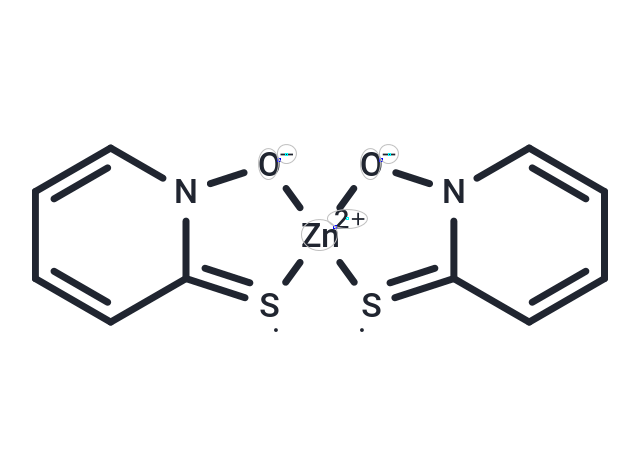Shopping Cart
- Remove All
 Your shopping cart is currently empty
Your shopping cart is currently empty

Zinc pyrithione (OM-1563), an antibacterial and antifungal agent can disrupt membrane transport by blocking the proton pump.

| Pack Size | Price | Availability | Quantity |
|---|---|---|---|
| 500 mg | $35 | In Stock | |
| 1 g | $47 | In Stock | |
| 5 g | $77 | In Stock | |
| 1 mL x 10 mM (in DMSO) | $48 | In Stock |
| Description | Zinc pyrithione (OM-1563), an antibacterial and antifungal agent can disrupt membrane transport by blocking the proton pump. |
| In vitro | In exposed mussel tissues, Zinc pyrithione accumulates rapidly, with the rate of accumulation being proportional to both exposure concentration and time. Despite a 7-day LC50 (lethal concentration for 50% of the population) of 8.27 μM in relatively higher concentrations of Zinc pyrithione, this indicates a potential threat to coastal ecosystems and marine life, necessitating further investigation into its sub-lethal biological effects. |
| In vivo | As a specific synthetic potentiator, Zinc pyrithione activates homotypic and heterotypic M channels by inducing a resting potential. It is considered a zinc complex. The Pyrithione ligand (formally a monoanion) chelates with Zn2+ through oxygen and iron-sulfur centers. In the crystalline state, Zinc pyrithione exists as a centrosymmetric dimer, with each zinc atom coordinated to two sulfur and three oxygen centers. However, in solution, the dimers dissociate through the cleavage of zinc-oxygen bonds. Although Zinc pyrithione is a dimer, its activity causing cytoplasmic membrane depolarization may originate from the monomer, with an effective concentration for half-maximum effect (K1/2) of approximately 0.3 mM. |
| Alias | OM-1563 |
| Molecular Weight | 317.71 |
| Formula | C10H8N2O2S2Zn |
| Cas No. | 13463-41-7 |
| Smiles | [Zn+2]12([O-]N3C(=[S]1)C=CC=C3)[O-]N4C(=[S]2)C=CC=C4 |
| Relative Density. | 1.782 g/cm3 at 25℃ |
| Storage | Powder: -20°C for 3 years | In solvent: -80°C for 1 year | Shipping with blue ice. | ||||||||||||||||||||||||||||||
| Solubility Information | Ethanol: < 1 mg/mL (insoluble or slightly soluble) DMSO: 20 mg/mL (62.95 mM), Sonication is recommended. | ||||||||||||||||||||||||||||||
Solution Preparation Table | |||||||||||||||||||||||||||||||
DMSO
| |||||||||||||||||||||||||||||||

Copyright © 2015-2025 TargetMol Chemicals Inc. All Rights Reserved.